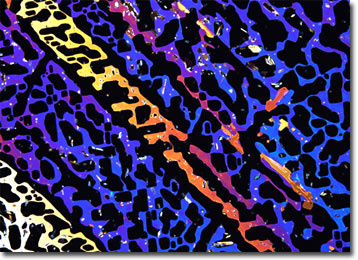Polarized Light Microscopy Digital Image Gallery
Vitamin B12
Vitamin B12, also known as cyanocobalamin, is an essential part of the diet of higher animals, such as humans. The water-soluble compound is only synthesized in nature, however, by microorganisms, such as bacteria and algae.

View a second image of Vitamin B12
It is generally agreed that adults should consume approximately 3 micrograms of vitamin B12 daily. Since plants are unable to synthesize the substance, they are not a good source of the vitamin. However, animal tissues, such as the liver and kidneys of cows and other ruminants, may contain significant quantities of the biochemical although they are also unable to synthesize the vitamin. This is because microorganisms in the gut of ruminants produce vitamin B12 and it is then transported to other tissues. Bivalve mollusks, such as clams and oysters, are also frequently excellent sources of the substance because they filter vitamin-synthesizing microorganisms from the water.
Vitamin B12 is extremely important in the production of red blood cells in the body. Insufficient absorption of the vitamin, typically originating from the absence of a substance called the intrinsic factor that is usually secreted by the parietal cells of the stomach, is the cause of the condition known as pernicious anemia. Resulting in an inadequate amount of vitamin B12 in the body, the condition is characterized by an impairment of red blood cell development and symptoms that include pallor, breathing difficulty, feebleness, elevated pulse, digestive problems, and neurological damage. The prognosis of sufferers has been quite good since the discovery of suitable treatments in the early twentieth century. However, before that time, the condition was commonly fatal.
